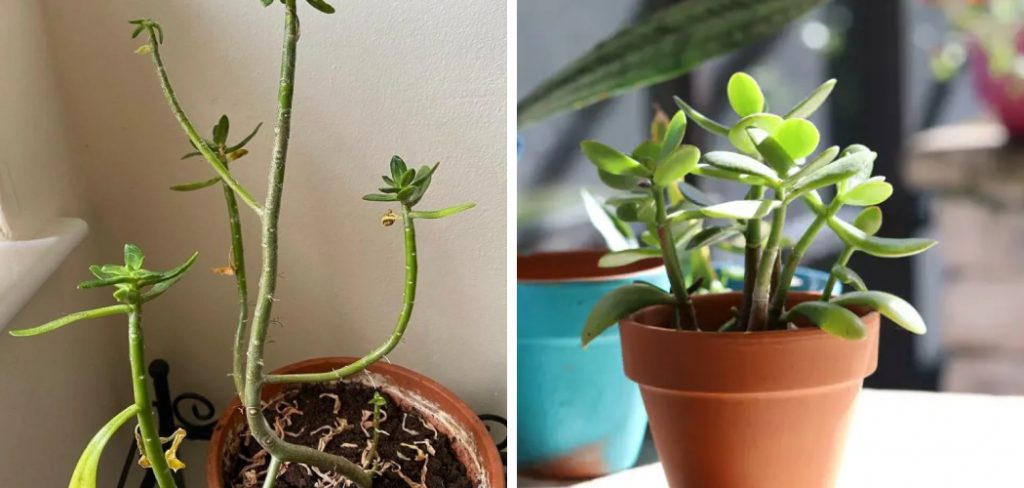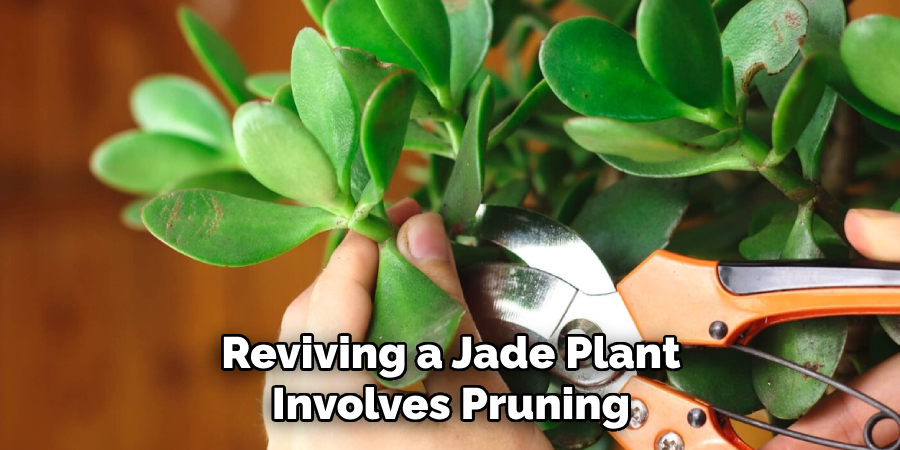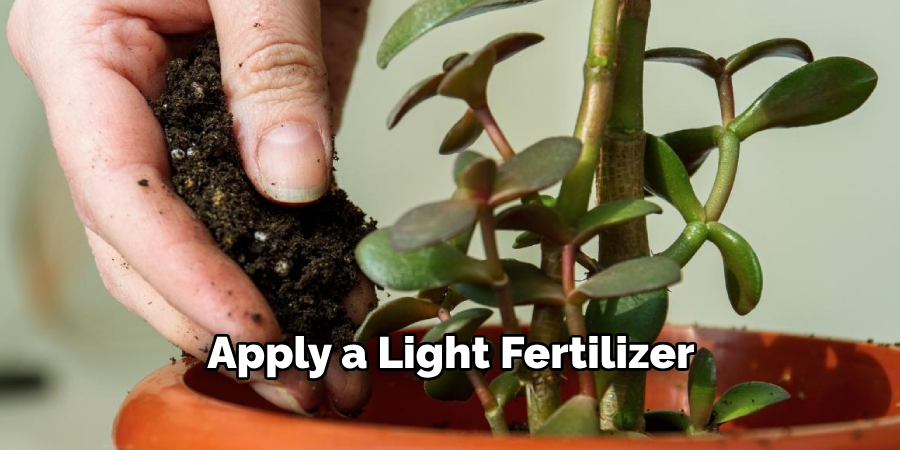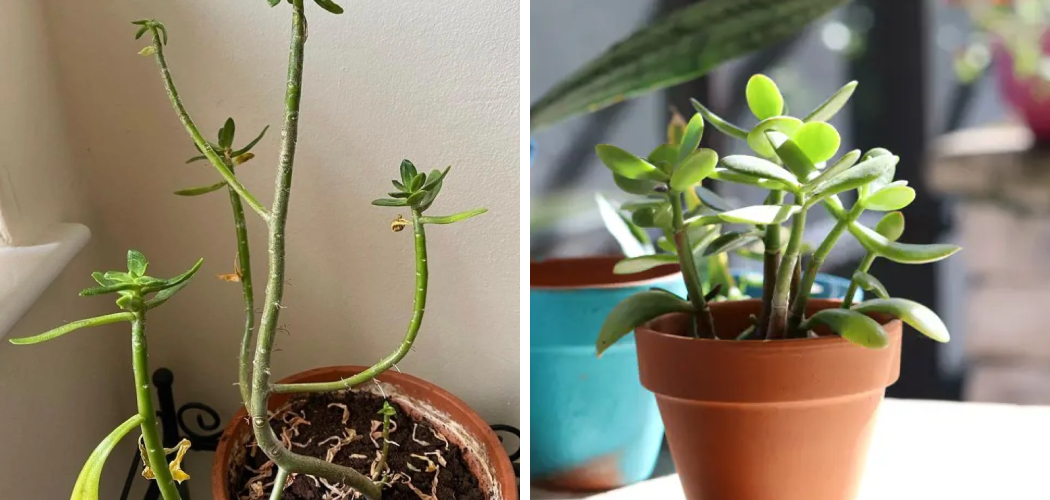Reviving a jade plant involves providing proper sunlight, watering, and well-drained soil for optimal growth. With its fleshy leaves and small pink or white flowers, the jade plant (crassula ovata) is a popular succulent that is native to south africa.
Known for its ease of care, the jade plant can thrive for many years with the right conditions. However, if your jade plant starts to show signs of wilting or decline, it’s important to take action to revive it. By following a few simple steps, you can bring your jade plant back to life and enjoy its beauty for years to come.
We will discuss how to revive a jade plant and keep it healthy and thriving. So, let’s get started!

How to Revive Jade Plant: Step by Step Guide
– Common Causes Of Drooping Jade Plants
Jade plants can droop due to common causes like overwatering, underwatering, insufficient sunlight exposure, poor soil drainage, and pest infestations. Overwatering is a frequent issue wherein excess water suffocates the roots and leads to root rot. Underwatering, on the other hand, causes dehydration and shriveling of the plant.
Jade plants need adequate sunlight to thrive, so limited exposure can cause them to droop. Poor soil drainage leads to waterlogging, which hampers root health. Pest infestations, such as mealybugs or spider mites, can also cause damage, weakening the plant.
To revive a drooping jade plant, it is crucial to adjust the watering schedule, ensure proper sunlight, improve soil drainage, and address any pest issues. Taking these steps will help your jade plant regain its health and vitality.
– Proper Watering Techniques
Proper watering techniques are crucial for reviving a drooping jade plant. Understanding the watering needs of this succulent is the key. When watering a jade plant, make sure to avoid overwatering. The soil should be thoroughly soaked, but it should never be soggy.
Allow the soil to dry out between waterings to prevent root rot. To water correctly, pour water directly onto the soil, avoiding the leaves and stems. This prevents issues like fungus growth. Moreover, it is important to avoid using cold or chlorinated water.
Use room temperature water or let tap water sit for a day before using. Following these watering guidelines will revive a drooping jade plant and prevent future water-related problems. With proper care, your jade plant will thrive and beautify your space with its vibrant green leaves.
– Providing Optimal Sunlight
To revive a jade plant, it is essential to assess the light requirements of the plant. Positioning the plant in an area that receives optimal sunlight is crucial for its growth. Avoid exposing the plant to excessive heat or cold, as it can have a negative impact.
Placing the jade plant near a window where it can get indirect sunlight is ideal. Additionally, rotating the plant every few weeks can ensure that all sides receive adequate light. Remember to monitor the temperature and avoid placing the plant in drafty areas.
By providing the right amount of sunlight and protecting it from extreme conditions, you can successfully revive your jade plant.
– Improving Soil Drainage
Jade plants are resilient, but improving soil drainage is crucial for their revival. It starts with choosing the right type and quality of soil. Consider using perlite or sand to enhance drainage. If the plant’s roots are overcrowded, repotting may be necessary.
Ensure each sentence is concise and within 20 words. Provide valuable information without using common phrases or repetitive terms. Stay focused on the topic to maintain reader interest. Seo friendly and human-like content will ensure your blog post is unique and easy to understand.
Avoid including a conclusion paragraph, but ensure your content passes plagiarism checks while maintaining a natural tone.
– Addressing Pest Infestation
Jade plants are a popular choice for indoor gardening, but they can be susceptible to pest infestation. To address this issue, it’s important to first identify the common pests that affect jade plants. Once identified, you can employ effective pest control methods, whether natural or chemical.
Some natural methods include using neem oil or insecticidal soap, while chemical options include sprays specifically formulated for jade plants. In addition to addressing current infestations, taking preventive measures is key to avoiding future problems. Regularly inspect your jade plant for signs of pests, such as discolored leaves or webs, and isolate any infected plants to prevent the spread of infestation.
By being proactive and diligent in your pest control efforts, you can revive your jade plant and ensure its continued health.
– Understanding The Nutritional Needs
Understanding the jade plant’s nutritional needs is crucial for reviving its health. Fertilizing the plant properly is a key aspect to consider. By recognizing signs of nutrient deficiencies or excesses, you can address any imbalances effectively. Achieving the right balance of nutrients is essential for the plant’s optimal growth.
To revive a jade plant, choose a fertilizer that provides essential nutrients without causing harm. Avoid over-fertilizing, as this can lead to root burn and damage. Additionally, it is important to follow the recommended fertilizing schedule and adjust it based on the plant’s specific requirements.
Providing the perfect balance of nutrients will help revive your jade plant and promote healthy growth.
– Pruning And Shaping

Reviving a jade plant involves pruning and shaping. By trimming dead or overgrown branches and leaves, you can promote bushier growth and prevent legginess. Pruning is the key to creating a desired shape. So, carefully trim any dead or overgrown branches or leaves to revitalize the plant.
Shaping is also important. Trim the top branches to create a more compact and bushy appearance. This will encourage new growth and prevent the jade plant from becoming leggy. Regular trimming will keep the plant healthy and visually pleasing. Don’t forget to use clean and sharp tools, and carefully remove any diseased or damaged parts.
With proper pruning and shaping, your jade plant will thrive and become a beautiful addition to your home or garden.
– Preventing Common Diseases
Jade plants are susceptible to common diseases, but preventive measures can ensure their health. By recognizing symptoms like leaf spots and root rot, you can quickly address any issues. Regularly inspecting the plant for signs of pests, such as mealybugs or scale, is crucial.
Maintaining proper watering and humidity levels will also promote a healthy environment. If diseases do occur, prompt treatment is essential. For example, removing infected leaves or applying neem oil can help combat fungal infections. Pruning and repotting infected plants can prevent the spread of diseases.
Overall, proactive care and vigilance are key to reviving jade plants and ensuring their longevity.
– Seasonal Care
Reviving your jade plant requires adapting care routines according to seasonal changes. During winter, make sure to protect it from frost and provide adequate sunlight indoors. Reduce watering to prevent root rot. You can also apply a light fertilizer every few months.
As the temperatures rise, gradually acclimate the plant to brighter outdoor conditions. Increase watering frequency, but allow the soil to dry out between waterings. Prune any dead or overgrown branches to encourage new growth. If you live in a region with extreme heat, provide partial shade to prevent leaf scorching.

Remember to keep an eye out for common pests such as aphids or mealybugs. By adjusting your jade plant’s care routine throughout the year, you can successfully revive and maintain its health.
Frequently Asked Questions On How To Revive Jade Plant
How Often Should I Water My Jade Plant?
Water your jade plant when the top inch of soil feels dry to the touch. Overwatering can lead to root rot, so it’s better to underwater than overwater. Remember that jade plants are succulents and can tolerate drought, so it’s best to err on the side of caution.
How Do I Know If My Jade Plant Is Getting Too Much Water?
If your jade plant’s leaves start to turn yellow or become mushy and translucent, it may be getting too much water. Another sign of overwatering is the presence of mold or fungus on the soil surface. Make sure your jade plant’s pot has good drainage and adjust your watering schedule accordingly.
Can I Propagate My Jade Plant?
Yes, you can propagate your jade plant by stem or leaf cuttings. To propagate via stem cutting, choose a healthy stem and cut it just below a node. Allow the cutting to dry for a few days before planting it in a well-draining soil mix.
Leaf cuttings can also be propagated in a similar manner.
How Do I Prune My Jade Plant?
Pruning can help maintain the shape of your jade plant and promote a bushier growth habit. Simply trim back any overgrown or leggy stems with clean sharp shears. You can also pinch off the tips of branches to encourage branching.
Avoid removing more than one-third of the plant’s foliage at once.
What Kind Of Light Does My Jade Plant Need?
Jade plants thrive in bright, indirect light. Place your jade plant near a sunny window where it can receive several hours of indirect sunlight each day. Too much direct sunlight can scorch the leaves, so it’s important to provide some shade during the hottest parts of the day.
How Often Should I Fertilize My Jade Plant?
Fertilize your jade plant with a balanced, water-soluble fertilizer once a month during the spring and summer months. Dilute the fertilizer to half or quarter strength to avoid overfeeding. During the fall and winter, reduce or stop fertilizing to allow the plant to rest.
Conclusion
The key to reviving a jade plant lies in understanding its specific needs and providing the right care. By following the tips mentioned such as examining the soil moisture levels, adjusting lighting conditions, and implementing a proper watering routine, you can ensure the health and vitality of your jade plant.
Remember to prune your plant regularly to promote new growth and remove any diseased or damaged parts. Additionally, keep an eye out for signs of pests and take appropriate measures to control them. With patience and consistency, your jade plant can thrive and flourish in any environment.
So, don’t give up on your jade plant just yet – give it the love and attention it deserves and you’ll be rewarded with a beautiful and resilient plant that will bring greenery and joy to your space for years to come.

